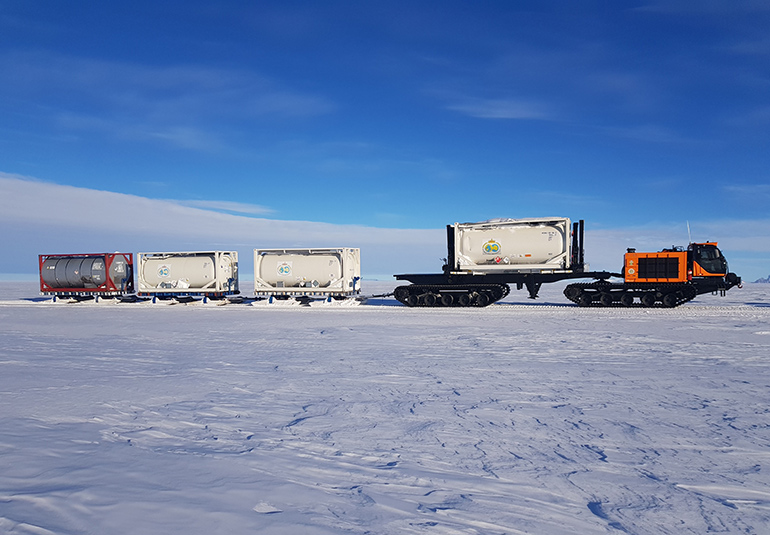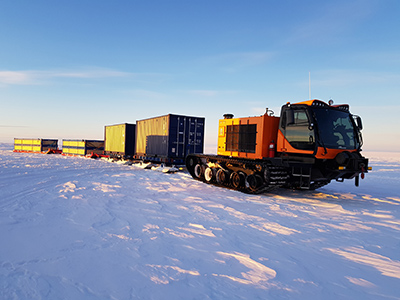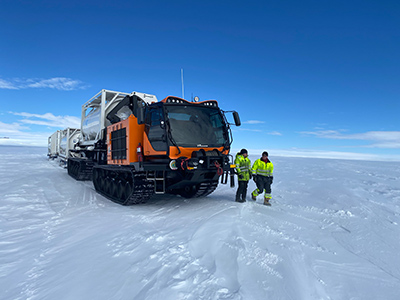An innovative design based on proven hydraulics and sophisticated controls ensured reliable and efficient performance.
Prinoth Panther tracked vehicles are used on challenging worksites around the world. The rubber-tracked crawler carriers minimize damage to the underlying terrain thanks to their low ground pressure and superior stability while carrying payloads of up to 23 tons. They’re typically used in mining, construction, oil and gas, and electric utility applications.

The company’s engineers are now pushing the machine’s all-weather, high-performance capabilities to new limits. Recently, Prinoth unveiled a vehicle unlike any other in the world that serves as a vital supply link to the Norwegian Troll Research Station in Jutulsessen, Antarctica. The station, which houses several dozen researchers, is a base for biological and geological field work, and for long-term monitoring of atmospheric, environmental and seismic activity. It is located 235 km (146 miles) from the coast.
The special transport vehicle, nicknamed the Troll Panther, is designed to move larger loads with less impact on the environment, compared with previous options, and with safety as the paramount priority. The aim was to reduce overall operational costs through lower fuel consumption, reduced total transport time and fewer personnel dedicated to delivering fuel and supplies in the Antarctic region.
“This project certainly challenged our teams to push boundaries and refine our know-how, and to come up with a cutting-edge machine to allow traveling in the harsh climate of the Antarctic while still providing high levels of productivity,” said Engineering Director Eric Steben, based in the company’s North American headquarters in Granby, Quebec.
“Our heritage at Prinoth is coming from snow groomers,” the types of machines widely used for prepping ski slopes and cross-country trails, he said. “So we understand how to engineer cold-weather machines. The Troll is used only in transport during the Antarctic summer, where the temperature is not so extremely low, perhaps down to around –25° C. Nonetheless, it is a unique vehicle in a unique setting, the only vehicle of its kind in the world — especially because it’s a four-track machine with highly sophisticated hydraulics to control all of the tracks.”
Machine platform
The Troll is based on a modified Prinoth Panther T16, the company’s largest rubber-track vehicle. It is powered by a transverse-mounted Caterpillar C15 diesel engine — a turbocharged unit rated at a maximum 580 hp and maximum torque of 1,958 lb-ft at 1,400 rpm.

It is actually a combination of two vehicles, a front T16 with the engine and cabin; and a hydraulically propelled trailer comprised of a second, nearly identical T16 chassis and undercarriage system with the same wheels, suspension, rollers and tracks.
The engine couples to a gear box that drives four hydraulic pumps. Each pump supplies a separate circuit and dedicated hydraulic motor on each of the four tracks. “The pumps are the same style that we use on all our snow groomers — Bosch Rexroth closed-circuit, variable-displacement hydrostatic pumps matched to Rexroth variable-displacement motors,” said Steben.
Hydraulic drive
The key to the propulsion system lies in the controls and software, he explained, because it is a complex task to deftly manage the hydraulics to both steer and continuously maintain and equalize traction on the four track drives. While the exact details are proprietary, the Troll’s hydraulics are managed by a specialized microcontroller built by TTControl, a joint venture of HYDAC International and TTTech.
TTControl specializes in robust and flexible control systems and intelligent displays that stand up to the harsh environments typical of off-highway vehicles and mobile machinery. The company’s ECUs, I/O modules and HMIs are used across Prinoth’s snow grooming line-up, comprising a standardized control platform that meets stringent requirements for quality, safety and performance.
Its master electronic control unit handles various tasks on the Troll, including controlling proportional valves and managing analog and digital inputs and outputs. It communicates via a standard CAN network. A state-of-the-art graphical HMI offers an operator interface that displays information relevant to machine processes as well as working and driving conditions.

In operation, steering wheel and throttle pedal input signals are interpreted at the controller which, in turn, initiates output signals to adjust pump output, manage valve functions, and precisely direct flow to each drive motor — and ultimately command vehicle motion and direction. “Adjusting the speed of each individual track lets us control the steering direction of the front and also the traction on the trailer, and ensure just the right amount of power is sent to the four track system,” said Steben.
Sensors on the pumps, motors and valves constantly read system pressure as well as the speed of each track, to monitor and compensate for any changes in the closed system. “When we bring all that information together at the machine computer, we can fine tune and precisely control every corner of the machine,” he said.
System modifications
Additional sensors monitor the temperature of critical systems, which is especially important for cold-start conditions. The vehicle’s main task is to transport goods from a seaside port to the research station, a one-way trip that takes three to four days. Overnight a generator electrically heats the fuel, coolant, hydraulic fluid and other systems to avoid a brutal cold-start in the morning.
Start-up includes a long period of idling when the operators watch systems’ temperatures as they warm up. Initial movements are quite slow, until components reach a reasonable temperature and the vehicle can accelerate to higher speeds. “The Norwegians are especially experienced with winter conditions and with working in Antarctica. They really know how to take care of the mechanical and electrical systems and use the machine gently,” said Steben.
Another cold-climate accommodation by the Prinoth engineers involves the hydraulic fluid. “We use an old-school, ATF Type-F fluid that has been used for years in hydraulic transmissions. It has very good properties at cold temperatures,” he said. It maintains a moderate viscosity that prevents restricted flow, controllability issues and sluggish operations. Yet at higher temperatures it still fully protects system components from wear and premature failure.
The fluid filtration requirements match the stringent recommendations for a conventional Panther. However, the filtration system is heated. An element inside the housing preheats the filter to avoid back-pressure or over-pressure during a cold start.
Likewise, pump cavitation could be a concern. “It is normally an issue with cold weather. But with 60+ years designing snow groomers, we are very used to it. So the Troll, like all our cold-weather line-up, uses a pressurized oil tank,” said Steben. The tank always supplies fluid to the pumps with a positive pressure, to prevent suction at the pump inlet. “Cavitation is something we want to avoid, that’s for sure,” he said.
Special seals aren’t needed on the Troll. Standard low-temperature elastomers proven on Prinoth’s snow groomer hydraulics have worked well here. “In this case, it was not cold enough to change to special materials such as silicone that might be required on an Antarctic winter machine.”
That said, leaks are totally unacceptable. “In Antarctica, everything is really, really strict, so spillage is not an option,” Steben emphasized. The entire continent is essentially considered a nature preserve, and an international environmental convention bans any discharge onto the ground or ice shelves. “We really take care that we have an essentially leak-free design. We do visual checks and regular inspections, and we also monitor for low fluid levels – to quickly spot any problems. All the hydraulic components are also designed for easy service.”
Safety first
While no redundancy was built into the machine, design criteria were higher than normal because failure was simply out of the question, said Steben. “Because of that we had to over-engineer a couple of hairier areas where we can’t afford any cracks or leaks.” For example, because the terrain can be rough, the trailer has been structurally reinforced with higher safety factors. And like the snow groomers, the Troll uses extreme-temperature hoses rated to –40° C. However, the hoses are one size larger than normal because, particularly in long runs, back pressure could be an issue in some cases. So the grade and size of the hoses have been slightly over designed.
Because of the proven components and ample experience with snow groomers, and with T16s used in winter conditions, few concerns cropped up during prototyping and testing in cold conditions. One minor issue was ice build-up on certain components, where slight adjustments were necessary.
Delivery and roll-out were problem free and, for the researchers, the Troll proved to be a welcome addition. Previously, the supply line involved several snow groomers dragging loaded sleds across the continent. Now, with more power, four tracks and better traction, the machine can carry heavy loads on the trailer and pull multiple sleds behind — up to 120 tons of cargo each trip. Travel speed is around 15 kph (9.3 mph), fully loaded.
“With one machine, they can transport more material with less fuel per ton, and at a lower cost,” said Steben. The Troll is now in regular operation in Antarctica for the season that normally runs from mid-November to March.
Prinoth
prinoth.com






